
I think that the chocolate cookie is the best part of the Oreo, but if you’re a fan of the creme, you just might want to do it yourself and make your own Mega-Stuf Oreo like the one pictured above.

I think that the chocolate cookie is the best part of the Oreo, but if you’re a fan of the creme, you just might want to do it yourself and make your own Mega-Stuf Oreo like the one pictured above.
If you walk around downtown Montreal, you’ll eventually run into one of these:
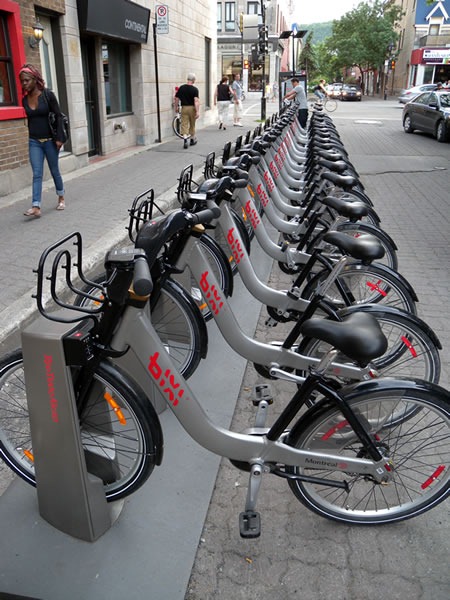
It’s one of 400 docking stations for Bixi, Montreal’s public bicycle sharing system. You shouldn’t think of Bixi as a bicycle rental service – instead, you should think of it more as self-powered public transit. With Bixi, you check out a bike at the Bixi station closest to your starting point, bike to the Bixi station closest to your destination, where you check it in.
In Montreal, there are 5,000 bikes in Bixi’s system, which was introduced last summer. Since then, a number of cities have signed up to purchase and install Bixi systems, including:

You can rent a bike in one of two ways:
You can purchase a subscription to the service online. This entitles you to unlimited rentals. Subscriptions are available at these rates:
With a subscription, bike rental is free if each trip between docking stations is under 30 minutes (other than the number of hours in the day, there’s no limit to the number of trips you can make). Trips longer than 30 minutes are charged as follows:
You can pay at the docking station on a per-use basis. This is the pricier approach, aimed at tourists and people who cycle only occasionally. The rates are:
The increasing prices are meant to discourage people from “hogging” the bikes; they’re meant to keep them in circulation.
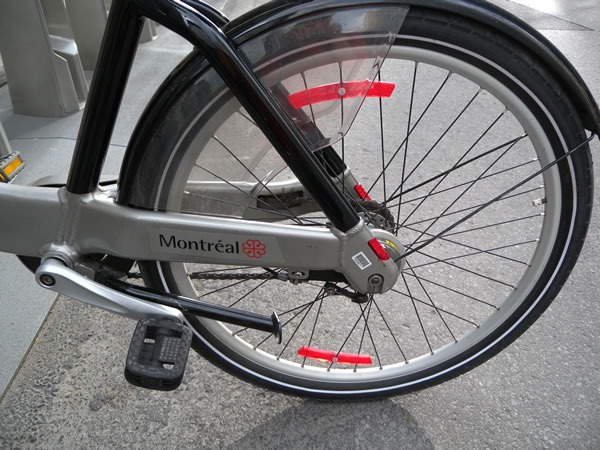
While in Montreal this past weekend, I decided to take a Bixi bike for a spin. I went to the docking station closest to my hotel, at the corner of Rene-Levesque and Mansfield. It’s a popular station; there were only two bikes left on that Saturday afternoon at about 4:30 p.m..
Like all Bixi stations, it had a map showing the locations of the Bixi stations, with that particular station highlighted:
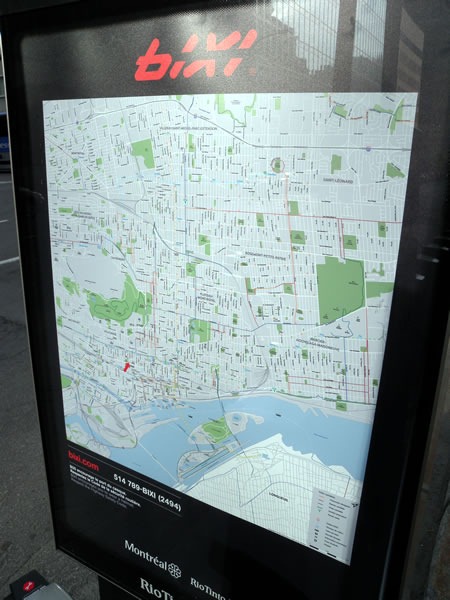
…as well as a control panel for renting a bike.
To rent a bike at the station, you touch the screen, which prompts you to swipe a credit card. Once your credit card has been authorized, you’re given a passcode which you use to unlock a bike. You can either have the passcode displayed onscreen (which means you have to memorize it) or have it printed out on a small ticket.
Although I have great faith in my memorization skills, I have even greater faith in Murphy’s Law. I opted for the printout.
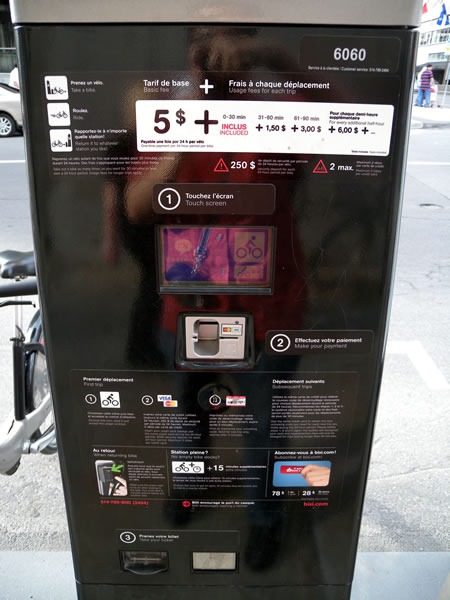
Once you have your passcode, it’s time to unlock your bike. The passcode is a five-digit number using only the digits 1, 2 and 3. You unlock a bike by typing that passcode using the keypad on the bike dock. If you entered your passcode correctly, you’ll see a green light and the electronic lock will release the bike.

The first bike I checked seemed in good shape and had full tires, so I entered my code and undocked it. I quickly adjusted the seat to match my height:

…and it was time to hit the road!
Here’s a look at the handlebars of a Bixi bike. The plastic covering on the handlebars serves two purposes:
The “basket” and integrated bungee cord are good for holding small packages and bags.
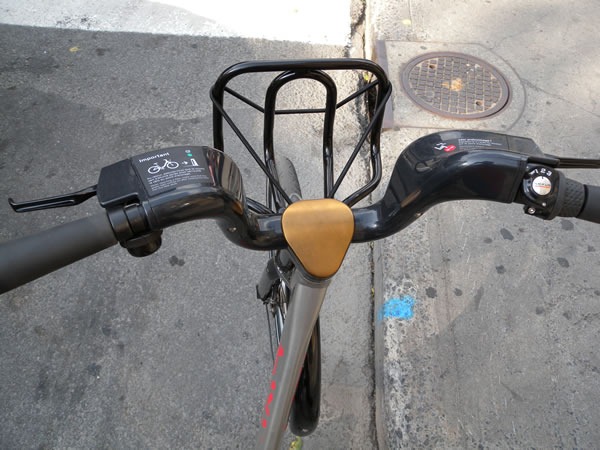
Here’s a close-up of the plastic covering over the left handbrake. It explains the finer points of returning a bike to the dock once you’re done with it:
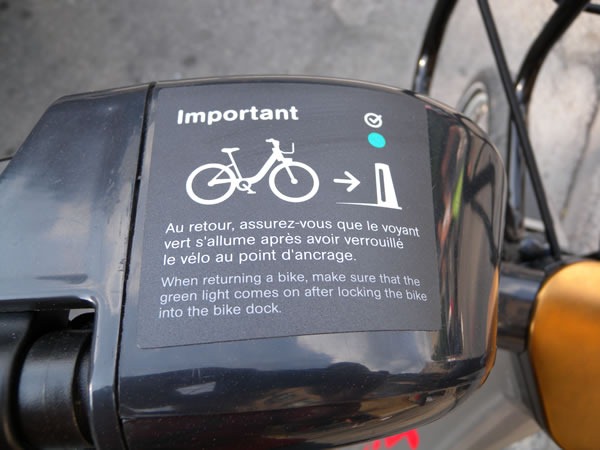
Here’s a close-up of the plastic covering over the right handbrake. It shows you how to report a damaged bike when returning it to the dock:
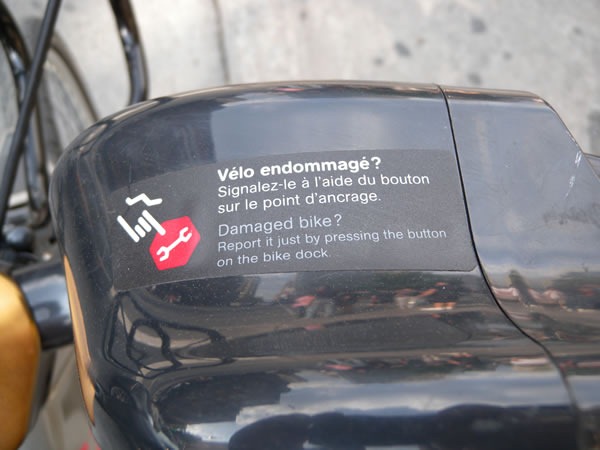
Here’s a shot of the rear wheel and pedals. Note that wherever possible, mechanical parts are sealed away out of view and harm’s way.

Bixi bikes are three-speed; they have a Shimano grip-shifter mounted on the right handle. You’re not going to win any races nor do any serious bike courier work on these gears, but it’s more than enough for city biking.
I didn’t have anywhere to be in a hurry, so I was using the bike like a velo-flaneur, doing a lot of looking around and just wandering where the road and the occasional whim took me. I kept a casual pace and stayed mostly in second and third gear, switching only to first gear for that hill going up St-Laurent from Ste-Catherine to Sherbrooke.
The bike has nice fat nitrogen-filled tires, and I found the ride to be pretty smooth. The gears shifted smoothly, although I noticed the occasional lag between gear changes as I shifted downwards – a mild annoyance rather than a serious problem. The chain was well lubed, and pedalling took very little effort. The brakes were nice and tight, requiring only a little squeeze before they engaged – they felt like my bike’s brakes just after a tune-up. The frame itself – a one-piece aluminum affair designed by Michel Dallaire with metal provided by Rio Tinto Alcan – was light (light for a “cruiser” style bike, anyway) and solid-feeling.
I made a quick jaunt from the Queen Elizabeth Hotel (where I was staying) to Old Montreal, where I tooled about its winding streets and caught some kind of festival, through le Quartier Chinois to the shops on St-Laurent north of Sherbrooke. From there, I checked out some of my old haunts in the McGill “student ghetto”, and then it was back to the docking station where I’d checked out the bike because I had a dinner reservation to catch.
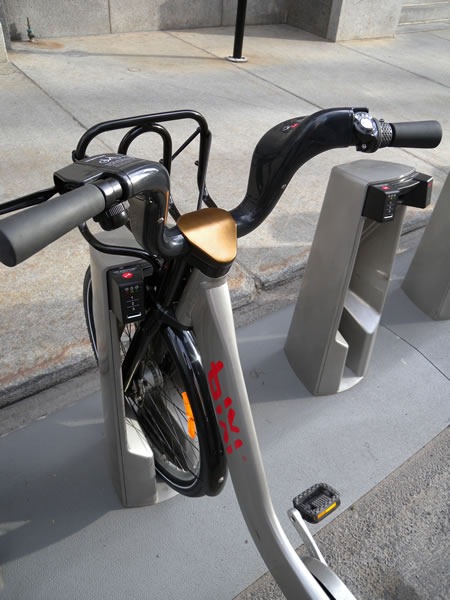
Returning the bike is easy – you find an empty dock and “plug” your bike into it. A green light confirms that you’ve locked the bike and that your rental session is over. If your bike is damaged in any way, you can report it by pressing the “report damage” button. I’d gone over a half-hour but was under an hour, so my total charge was $6.50.
Bixi is a Montreal-based company, and its bike sharing system seems to work well there. While walking about during my stay there over the past couple of days, I saw more than a dozen people on Bixi bikes, and saw even more during my Bixi bike jaunt on Saturday afternoon.
Montreal has a couple of advantages that make it suitable for a bike sharing system:
Will the Bixi experience in Montreal “translate” to Toronto? I don’t know.
Toronto is more “American” than Montreal, so many more people there perceive bikes as toys rather than serious vehicles. A number of Toronto politicians have know-nothingly painted bicycle activism as “the war on the car” and at least a couple of them have attempted to turn modest proposals to get more dedicated lanes on city streets into an issue for the upcoming mayoral election (with opposing them seen as a way of getting more votes).
There’s also the matter of city coverage. When the Bixi project launched in Montreal, they started with 300 stations and 3,000 bikes, which meant that a for a good part of the city, it was likely that there was a Bixi docking station nearby and it was likely that that station would have at least one bike available. Since then, those numbers have been boosted to 400 stations and 5,000 bikes. You see both stations and bikes (both docked and in use) everywhere.
Despite the fact that Toronto has a population larger than Montreal’s, we’re launching with 100 stations and 1,000 bikes. I assume that most of them will be in the core, with the concentrations heaviest around the streets with bike lanes or a high hipster quotient. Will it be enough stations and bikes? We’ll find out as the service launches.
Finally, there’s the question of whether the bikes will get used in the winter. One of the favourite arguments of opponents of bike lanes is that nobody bikes in the winter. While cycling is reduced, there are still many cyclists on the street of Toronto in the winter months. Toronto doesn’t get anywhere near as much snow or anywhere as cold as Montreal, and even they have a year-round biking culture. As a year-round cyclist who regularly shuttles between High Park and downtown Toronto on his bike, I can say with certainty that winter cycling in Toronto is no big deal.
I’m in Montreal every couple of months for conferences, so I think I’d end up using Bixi when visiting. These events often call for quick errands to be run, and being able to get a bike would come in handy.
Would I use Bixi in Toronto even though I live in the city and have my own bike? There are times that bike rental would come in handy. For the rare times when I drive downtown or the more frequent times when I take the subway downtown but have to run errands all over the place, Bixi would come in handy.
I’m looking forward to seeing Bixi in Toronto. We’ll have to see if it works out.
The Hand Eye Society describes itself as a “not-for-profit coalition of people and projects in support of Toronto’s videogame communities”. Their goals are:
I shouldn’t be surprised that one of the people behind the Hand Eye Society is Jim Munroe. He’s a former Adbusters editor turned self-publishing author of a number of enjoyable science fiction books such Flyboy Action Hero Comes with Gasmask and Angry Young Spaceman, developer of indie games including the interactive fiction piece Punk Points (the online version requires Java), maker of movies and all-round Toronto DIY-espousing creative type.
Also connected with the Hand Eye Society are other indie videogame notables including:
The Hand Eye Society is throwing a social this Thursday, May 27th in Toronto at Unit Bar (1198 Queen Street West, a shade east of Dufferin/Gladstone, halfway between the Drake and Gladstone hotels). The doors will open at 7:00 and there may be a set of curated videogames for you to check out.
At 8:00 p.m. special guest dignitary Brandon Boyer, Chairman of the Independent Games Festival and contributing editor for Boing Boing and Boing Boing’s games blog Offworld, will, as the Hand Eye Society’s blog puts it, “deliver some form of immensely significant communication to the assembled videogame creators, enthusiasts, organizers & slack-jawed onlookers.”
If I weren’t going to be in Montreal that evening for the Make Web Not War conference, I’d most certainly at this event (I’ll definitely catch the next social). If you’re in Toronto and love videogames (especially ones that break from the mainstream) and especially if you love making them, catch the Hand Eye Society’s social this Thursday!

He would’ve been 102 today. I’m celebrating his birthday because he’s a fellow accordion player, and like me, he’s played the accordion to make ends meet. When he graduated from Princeton with a degree in architecture during the great depression, there wasn’t any work in his field. He took a job playing accordion with a summer stock troupe in Cape Code, where he met Henry Fonda, got a role on Broadway and eventually ended up in film.
For more on Jimmy Stewart, see his entries in Finding Dulcinea and Wikipedia.

The blog Geeks are Sexy put together a wonderful alphabet rhyme using Creative Commons “share-alike”-licensed photos on Flickr, which I thought I’d share with you:
Here’s the text of the rhyme, along with a credit for each corresponding photo:
A is for Away Team, where you should never wear red (mild mannered photographer)
B is for Binary, 1s and 0s in your head (jpstanley)
C is for Cosplay, making cons an awesome place
D is for Doctor, who keeps changing face (great beyond)
E is for Emoticons, that tell you what we’re feeling (neal gillis)
F is for Flickr, whose photos we are “stealing” (tricky)
G is for Gadgets, the way to our heart (slipstreamjc)
H is for Hardware, I took it apart! (jurvetson)
I is for iEverything, love it or hate it (dan dickinson)
J is for Japan, we’re glad Nintendo invaded (oscar mota)
K is for Keyboard, we love every letter (andrew*)
L is for Leias, the more the better! (koadmunkee)
M is for MMORPGs, it’s a magical place (i eated a cookie)
N is for NASA, and the beauty of space (nasa1fan)
O is for Occipital Lobe, we love using our brains (illuminaut)
P is for Programming, ((though lisp is a pain)) (phil_jackson)
Q is for Quilting, and other geeky crafts (athenamat)
R is for Reading, no matter what the path (timonoko)
S is for Science, though the cake is a lie (don solo)
T is for Tabletop, and a 20-sided die (nengard)
U is for Uncertainty, you just never know (neil crosby)
V is for Voltage, oh the places we’ll go! (oskay)
W is for the World Wide Web, it’s more than just porn (shimown)
X is for Xerox, where so much geekiness was born (marc smith)
Y is for Youth, since kids are geeks too (benmcleod)
Z is for Zork, watch out for the grue! (the_tml)
